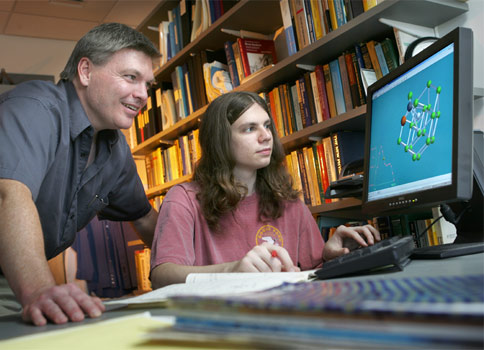After only his first year at Lafayette, Victor Fiore ’08 (Clarks Summit, Pa.) spent his summer conducting research in computational chemical kinetics, a project usually reserved for upperclassmen or graduate students.
Fiore collaborated with Kenneth Haug, associate professor of chemistry, as part of the EXCEL Scholars program. The researchers explored chlorodifluourmetane, or HCFC-22, used in refrigerators and air conditioners as a replacement for CFC-12, an ozone-destroying compound.
In Lafayette’s distinctive EXCEL Scholars program, students conduct research with faculty while earning a stipend. The program has helped to make Lafayette a national leader in undergraduate research. Many of the more than 160 students who participate each year share their work through articles in academic journals and/or conference presentations.
The researchers did experiments with HCFC-22 to understand its reactions with the common catalyst nickel.
“I was modeling various structures [of HCFC-22], moving the atoms around to see how they would react,” Fiore explains. “If we move this molecule here, what would it do? Then we explored what happens with the reaction.”
Though HCFC-22 is more environmentally sound than CFC-12, it does have its own pitfalls. Haug wanted to study the decomposition reactions to gain a better understanding of these problems.
Using complex programs, Fiore determined numerous variables and parameters for the compounds, then simulated chemical reactions in a computer model.
“I’d move the molecule a certain way, changing its position relative to the nickel, trying to make a reaction take place,” he explains. “It was always a challenge to get it to do what I wanted it to do, what I thought it would do. So, I had to try different ways to get through that pathway; you never know if the molecule will do what you expect.”
Fiore also gained experience with the Schrodinger equation, which describes molecular structure and dynamics.
“It’s a very complex equation, and it’s the fundamental equation for subatomic particle reactions,” he says. “Learning more about it will really benefit me in future classes.”
“Doing EXCEL research as a freshman is a little early, but he is very motivated, very dedicated. I have been very happy with him,” says Haug. “It is a challenge to do what he did. This was a complicated structure he dealt with and difficult to program, so it was a matter of constantly trying to understand how the program would handle the molecule. He did a great job. In fact, he probably has more experience with this molecule on the program than I do!”
Fiore is grateful that he had the opportunity to see how research works so early in his college career.
“It was a little daunting at first, but I got used to it,” he says. “I’m a lot more comfortable interacting with Professor Haug now. The EXCEL project allows you to go down your own path. In class, you are told what to study and what to do; here you explore more on your own.”
Haug has shared his research in 29 academic journal articles, five book chapters, and numerous national conference presentations. Since joining the faculty in 1997, he has mentored seven students in EXCEL projects, noting that the program gives students more than an acquisition of knowledge.
“One of the differences between class lab work and research is the level of organization needed,” he explains. “Labs are three hours long, but research goes on for weeks and months, and one has to reach a higher level of organization, documenting what has been done. There are a lot of methodology issues in research that aren’t necessary in class and lab semester work, so this experience was a great benefit to Vic.”
As a national leader in undergraduate research, Lafayette sends one of the largest contingents to the National Conference on Undergraduate Research each year. Thirty-nine students were accepted to present their research at this year’s conference.

Victor Fiore ’08 did research in computational chemical kinetics as an EXCEL research assistant to Kenneth Haug, associate professor of chemistry.
